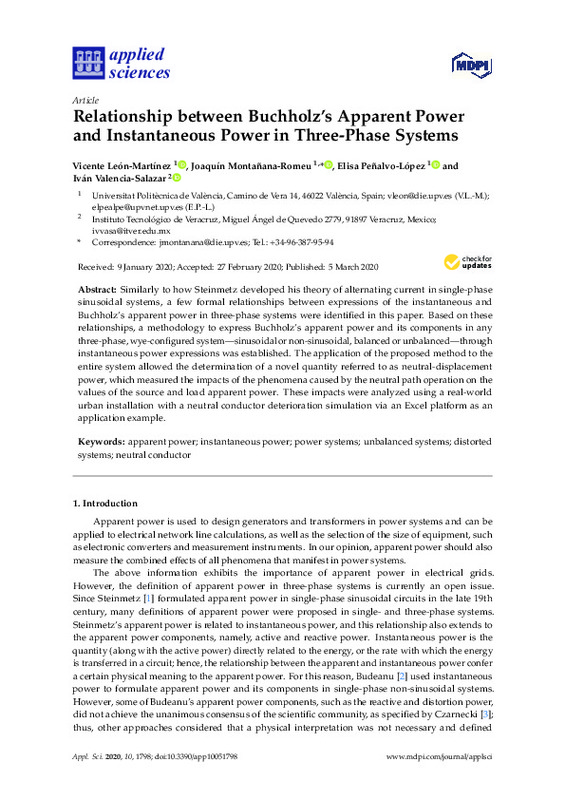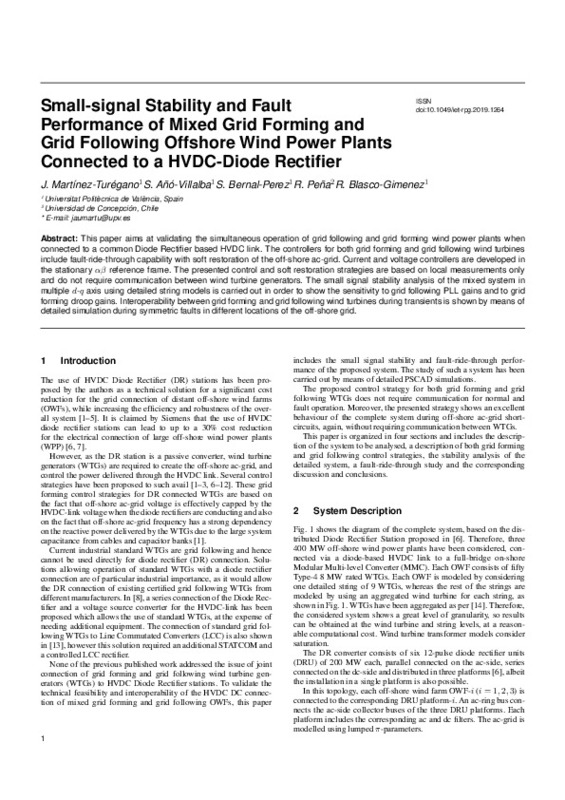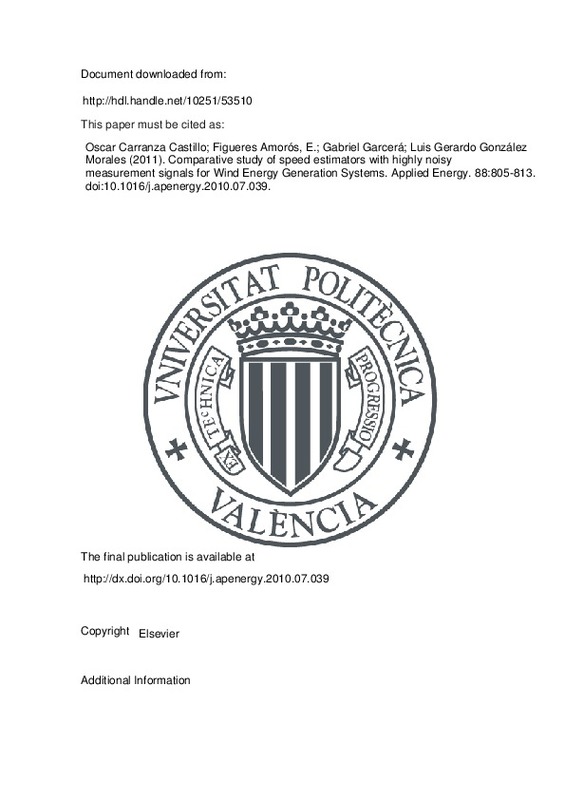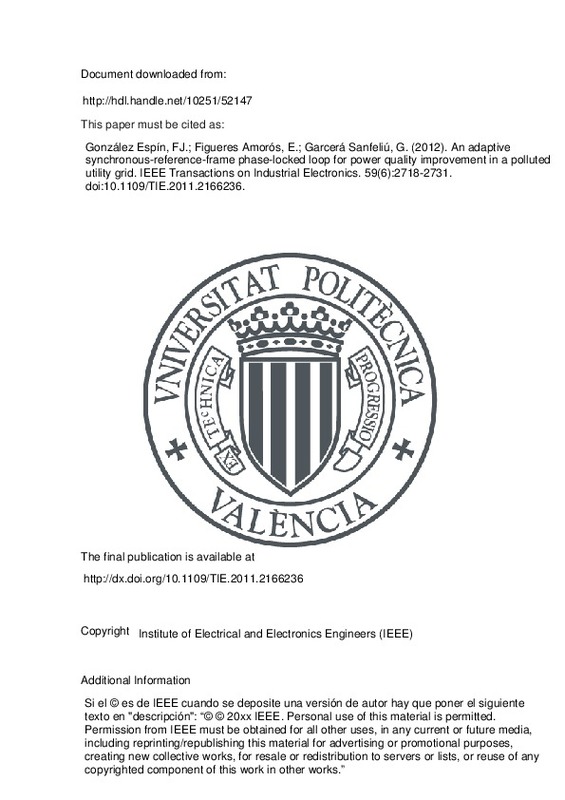JavaScript is disabled for your browser. Some features of this site may not work without it.
Buscar en RiuNet
Listar
Mi cuenta
Estadísticas
Ayuda RiuNet
Admin. UPV
Relationship between Buchholz's Apparent Power and Instantaneous Power in Three-Phase Systems
Mostrar el registro sencillo del ítem
Ficheros en el ítem
| dc.contributor.author | León-Martínez, Vicente
|
es_ES |
| dc.contributor.author | Montañana-Romeu, Joaquín
|
es_ES |
| dc.contributor.author | Peñalvo-López, Elisa
|
es_ES |
| dc.contributor.author | Valencia-Salazar, Iván
|
es_ES |
| dc.date.accessioned | 2021-05-21T03:32:05Z | |
| dc.date.available | 2021-05-21T03:32:05Z | |
| dc.date.issued | 2020-03-05 | es_ES |
| dc.identifier.uri | http://hdl.handle.net/10251/166590 | |
| dc.description.abstract | [EN] Similarly to how Steinmetz developed his theory of alternating current in single-phase sinusoidal systems, a few formal relationships between expressions of the instantaneous and Buchholz's apparent power in three-phase systems were identified in this paper. Based on these relationships, a methodology to express Buchholz's apparent power and its components in any three-phase, wye-configured system-sinusoidal or non-sinusoidal, balanced or unbalanced-through instantaneous power expressions was established. The application of the proposed method to the entire system allowed the determination of a novel quantity referred to as neutral-displacement power, which measured the impacts of the phenomena caused by the neutral path operation on the values of the source and load apparent power. These impacts were analyzed using a real-world urban installation with a neutral conductor deterioration simulation via an Excel platform as an application example. | es_ES |
| dc.description.sponsorship | This research was funded by the European Commission, grant number 847132. The APC was funded by the European Commission, grant number 847132. We gratefully thank Eléctrica de Vinalesa, S.L.U., for allowing us to take measurements using their electrical networks, and MDPI (www.mdpi.com/authors/english) for their English language editing. The authors deeply thank the European Commission for their support and funding provision. | es_ES |
| dc.language | Inglés | es_ES |
| dc.publisher | MDPI AG | es_ES |
| dc.relation.ispartof | Applied Sciences | es_ES |
| dc.rights | Reconocimiento (by) | es_ES |
| dc.subject | Apparent power | es_ES |
| dc.subject | Instantaneous power | es_ES |
| dc.subject | Power systems | es_ES |
| dc.subject | Unbalanced systems | es_ES |
| dc.subject | Distorted systems | es_ES |
| dc.subject | Neutral conductor | es_ES |
| dc.subject.classification | INGENIERIA ELECTRICA | es_ES |
| dc.title | Relationship between Buchholz's Apparent Power and Instantaneous Power in Three-Phase Systems | es_ES |
| dc.type | Artículo | es_ES |
| dc.identifier.doi | 10.3390/app10051798 | es_ES |
| dc.relation.projectID | info:eu-repo/grantAgreement/EC/H2020/847132/EU/A holistic framework for Empowering SME's capacity to increase their energy efficiency/ | es_ES |
| dc.rights.accessRights | Abierto | es_ES |
| dc.contributor.affiliation | Universitat Politècnica de València. Departamento de Ingeniería Eléctrica - Departament d'Enginyeria Elèctrica | es_ES |
| dc.description.bibliographicCitation | León-Martínez, V.; Montañana-Romeu, J.; Peñalvo-López, E.; Valencia-Salazar, I. (2020). Relationship between Buchholz's Apparent Power and Instantaneous Power in Three-Phase Systems. Applied Sciences. 10(5):1-15. https://doi.org/10.3390/app10051798 | es_ES |
| dc.description.accrualMethod | S | es_ES |
| dc.relation.publisherversion | https://doi.org/10.3390/app10051798 | es_ES |
| dc.description.upvformatpinicio | 1 | es_ES |
| dc.description.upvformatpfin | 15 | es_ES |
| dc.type.version | info:eu-repo/semantics/publishedVersion | es_ES |
| dc.description.volume | 10 | es_ES |
| dc.description.issue | 5 | es_ES |
| dc.identifier.eissn | 2076-3417 | es_ES |
| dc.relation.pasarela | S\404870 | es_ES |
| dc.contributor.funder | European Commission | es_ES |
| dc.description.references | Czarnecki, L. S. (1987). What is wrong with the Budeanu concept of reactive and distortion power and why it should be abandoned. IEEE Transactions on Instrumentation and Measurement, IM-36(3), 834-837. doi:10.1109/tim.1987.6312797 | es_ES |
| dc.description.references | Czarnecki, L. S. (1988). Orthogonal decomposition of the currents in a 3-phase nonlinear asymmetrical circuit with a nonsinusoidal voltage source. IEEE Transactions on Instrumentation and Measurement, 37(1), 30-34. doi:10.1109/19.2658 | es_ES |
| dc.description.references | Czarnecki, L. S. (2008). Currents’ Physical Components (CPC) concept: A fundamental of power theory. 2008 International School on Nonsinusoidal Currents and Compensation. doi:10.1109/isncc.2008.4627483 | es_ES |
| dc.description.references | CZARNECKI, L. (2015). Currents’ Physical Components (CPC) in Three-Phase Systems with Asymmetrical Voltage. PRZEGLĄD ELEKTROTECHNICZNY, 1(6), 42-49. doi:10.15199/48.2015.06.06 | es_ES |
| dc.description.references | Emanuel, A. E. (1999). Apparent power definitions for three-phase systems. IEEE Transactions on Power Delivery, 14(3), 767-772. doi:10.1109/61.772313 | es_ES |
| dc.description.references | Pajic, S., & Emanuel, A. E. (2006). Modern Apparent Power Definitions: Theoretical Versus Practical Approach—The General Case. IEEE Transactions on Power Delivery, 21(4), 1787-1792. doi:10.1109/tpwrd.2006.876647 | es_ES |
| dc.description.references | Depenbrock, M. (1993). The FBD-method, a generally applicable tool for analyzing power relations. IEEE Transactions on Power Systems, 8(2), 381-387. doi:10.1109/59.260849 | es_ES |
| dc.description.references | Ferrero, A. (2007). Definitions of electrical quantities commonly used in non-sinusoidal conditions. European Transactions on Electrical Power, 8(4), 235-240. doi:10.1002/etep.4450080403 | es_ES |
| dc.description.references | Curtis, H. L., & Silsbee, F. B. (1935). Definitions of power and related quantities. Electrical Engineering, 54(4), 394-404. doi:10.1109/ee.1935.6539147 | es_ES |
| dc.description.references | Emanuel, A. E., & Orr, J. A. (s. f.). The effect of neutral path impedance on voltage and current distortion. Part I. symmetrical and balanced three-phase systems. 2004 11th International Conference on Harmonics and Quality of Power (IEEE Cat. No.04EX951). doi:10.1109/ichqp.2004.1409351 | es_ES |
| dc.description.references | Emanuel, A. E., & Orr, J. A. (s. f.). The effect of neutral path impedance on voltage and current distortion. Part II. Imbalanced three-phase systems. 2004 11th International Conference on Harmonics and Quality of Power (IEEE Cat. No.04EX951). doi:10.1109/ichqp.2004.1409350 | es_ES |
| dc.description.references | Blasco, P. A., Montoya-Mira, R., Diez, J. M., Montoya, R., & Reig, M. J. (2019). Compensation of Reactive Power and Unbalanced Power in Three-Phase Three-Wire Systems Connected to an Infinite Power Network. Applied Sciences, 10(1), 113. doi:10.3390/app10010113 | es_ES |
| dc.description.references | Akagi, H., Kanazawa, Y., & Nabae, A. (1984). Instantaneous Reactive Power Compensators Comprising Switching Devices without Energy Storage Components. IEEE Transactions on Industry Applications, IA-20(3), 625-630. doi:10.1109/tia.1984.4504460 | es_ES |
| dc.description.references | Czarnecki, L. S. (2006). Could Power Properties of Three-Phase Systems Be Described in Terms of the Poynting Vector? IEEE Transactions on Power Delivery, 21(1), 339-344. doi:10.1109/tpwrd.2005.852353 | es_ES |
| dc.description.references | Jeon, S. (2015). Properties of the generalised power theory: universality and partitioning/augmentation properties. IET Generation, Transmission & Distribution, 9(15), 2126-2134. doi:10.1049/iet-gtd.2014.0303 | es_ES |
| dc.description.references | Czarnecki, L. S. (2015). Critical comments on the Conservative Power Theory (CPT). 2015 International School on Nonsinusoidal Currents and Compensation (ISNCC). doi:10.1109/isncc.2015.7174713 | es_ES |
| dc.description.references | Artemenko, M. Y., & Batrak, L. M. (2017). The new formula for apparent power and power losses of three-phase four-wire system. 2017 IEEE 37th International Conference on Electronics and Nanotechnology (ELNANO). doi:10.1109/elnano.2017.7939784 | es_ES |











